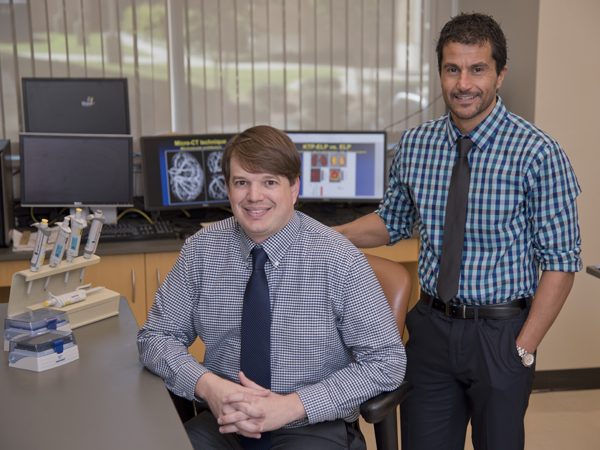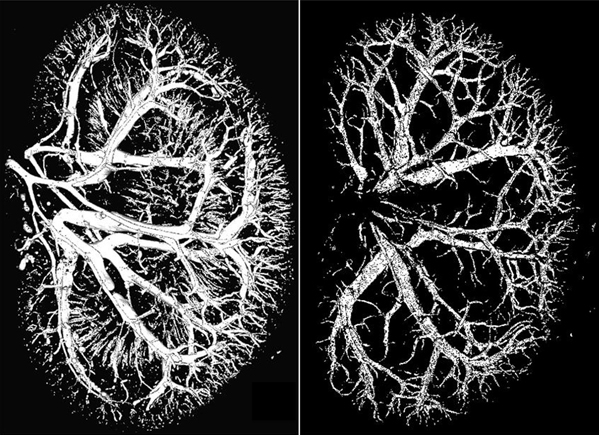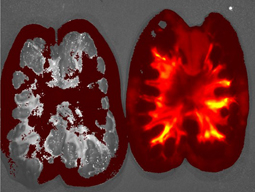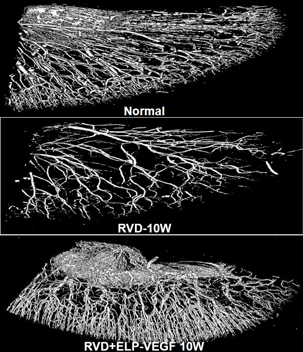Researchers, molecules team up to fight kidney disease

Published in News Stories on November 30, 2015
Dr. Alejandro Chade had a problem. All he needed was some ELP.
Biotechnology developed by a University of Mississippi Medical Center team could become a new treatment for renal vascular disease (RVD). In a study published online in November by the Journal of the American Society for Nephrology, the work demonstrates how an elastin-like polypeptide (ELP) fused with vascular endothelial growth factor (VEGF) promotes blood vessel repair, formation, and function in damaged kidney tissues.
“This is completely new,” said Chade, UMMC associate professor of physiology, medicine, and radiology and lead author of the paper. He studies RVD and potential treatments.
About ten percent of adults have RVD. Blood vessels in the kidneys become hard and blocked with plaque which restricts blood flow. This damages downstream parts of the kidney and can decrease its filtration abilities. According to Chade, current therapies like artery-opening stents do not improve outcomes in nearly half of RVD patients.

A micro-CT scan showing the blood vessels of healthy (left) and damaged (right) kidneys. (Image courtesy of A. Chade)
In RVD, kidneys may have difficulty producing VEGFs, proteins that promote vessel growth. “We all have VEGF,” said Chade, “but we showed that progressive renal damage in this disease correlates with a decrease in VEGF.” In earlier work, he injected VEGF into damaged kidneys to stimulate blood vessel production. Unfortunately, it breaks down quickly before reaching its full medicinal potential.
“VEGF treatment replenishes and protects the kidneys, but not enough to recover,” said Chade.
In 2013, Chade attended a talk by Dr. Lee Bidwell, assistant professor of neurology and biochemistry at UMMC. Bidwell uses ELPs to test targeted cancer drug delivery. ELPs are a repeating amino acid chain that can be fused to most small molecules, like VEGF. Bidwell had never heard of anyone using ELPs for kidney therapies, but he saw their potential value.

A fluorescent tag allows Chade and Bidwell to view VEGF-ELP accumulation in the kidney on the right. The left kidney did not receive the treatment. (Photo courtesy of A. Chade)
ELPs accumulate in kidneys, said Bidwell. That can be a serious problem if attached to a cancer drug meant for another target, but what about a drug for treating renal vascular disease?
“I thought, 'let's take advantage of this quality and do something good for the kidneys'”, said Bidwell.
Chade, Bidwell, and their team fused the two molecules together to create VEGF-ELP. They infused one dose of this treatment directly into RVD kidneys in pigs. After four weeks, those that received the treatment had a network of microvascular tubes denser than those that were untreated or received VEGF alone.

Vessel formation in healthy (top), RVD damaged (middle), and VEGF-ELP treated (bottom) kidneys. (Image courtesy of A. Chade)
To track the kidney's function, the team measured renal blood flow and glomerular filtration rate. Low values for these measurements mean that the kidneys aren't working well. The VEGF alone treatment increased blood flow by about 40 percent, but filtration was unchanged. In comparison, blood flow and filtration rate in the VEGF-ELP-treated kidneys was up over 70 percent. Fusing the two compounds allowed VEGF to work more effectively.
Other important findings were the decrease in fibrosis-producing proteins, reduced damage to podocytes (important filtering cells), and less protein in urine, which all suggested that the kidney damage may have been stopped or slowed by VEGF-ELP.
Kidneys that received VEGF-ELP started to produce more of their own VEGF, suggesting a cascading effect. It's a significant finding because RVD patients have lower VEGF production.
According to Chade and Bidwell, this is the first time an ELP has been used for drug delivery into a kidney. They filed a patent for the technology on November 12. UMMC holds other patents, invented by Bidwell and Dr. Drazen Raucher, professor of biochemistry, for cancer-treating ELP technologies.
In the future, Chade and Bidwell will test other time points for delivery and giving VEGF-ELP in conjunction with treatments like stents. They also intend to add a third part to the complex: a kidney-targeting peptide that would allow the drug to go to the kidney after being injected in a remote vessel like a vein in the arm, instead of the more invasive intrarenal procedure.
One unanswered question is the effectiveness of the treatment in more advanced conditions. A patient with chronic or end stage renal failure may have damage that VEGF-ELP cannot reverse. It will also be a long time before a drug is ready for clinical trials, possibly 10 years or more, Chade and Bidwell said.
However, Chade is very optimistic about the findings, which he called “exciting” and a potential “breakthrough” in the paper.
“It's a solid, but very first step,” said Chade.
The paper, titled “Renal therapeutic angiogenesis using a bioengineered polymer-stabilized vascular endothelial growth factor construct,” can be found here. The National Institutes of Health and the American Heart Association provided funding for the study.


